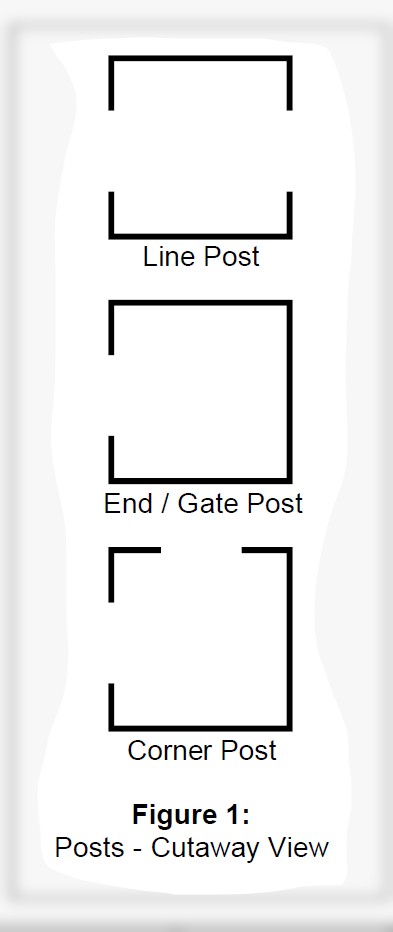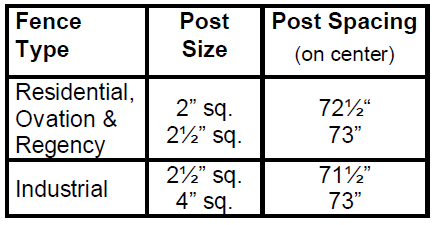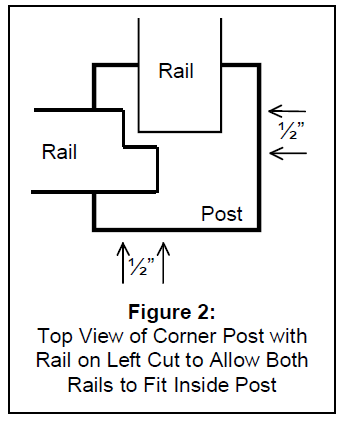Please read these instructions thoroughly before attempting to install your Jerith fence. While installation of our fence is relatively easy, this instruction sheet should eliminate any guess work. Jerith offers full support for their fencing installation. If you have any questions or problems installing the fence, please call Jerith weekdays at 1-800-344-2242 so they may help you.
Materials Needed:
- Stakes
- String
- Measuring Tape
- Rubber Mallet
- Post Hole Digger
- Level
- Concrete Mix
- Hacksaw
- Hex-Head Driver
Before You Begin Installing Your Fence:
- Establish your fence line by staking out the area to be enclosed and attaching a guide string to the stakes. Make sure the fence is set back from the property line as required by local codes.
- Separate and identify your posts. There are three types of posts: Line, End/Gate, and Corner posts. The horizontal rails of the fence sections fit into the holes punched in the posts. Line posts have holes punched on opposite sides. Corner posts have adjacent sides punched. End posts have holes on only one side. (See Figure 1.) A Gate post is the same as an End post but the post walls are twice as heavy to support the weight and latching of a gate.
- Drive the standard post caps onto the posts using a rubber mallet before setting the posts in concrete. This will prevent the posts from being knocked out of alignment after the concrete has been poured. Ball caps may be put on after the fence is installed.
- Gates and sections should be installed so that the bottom of the fence is about 2” – 3” above ground level. This will allow the grass under the fence to be easily trimmed.
- For Industrial Fence, all screws in the fence sections and the posts should be installed on the same side (normally the inside) of the enclosed area for a neater appearance when you are done.
- When you need less than a full section to complete a line of fence, cut it to size using a hacksaw. Notch the cut ends of the horizontal rails so they will fit inside the post. Use a factory notch as a guide.
- Mix the concrete for the posts holes on the dry side to allow the posts to set faster and to give additional support when installing the fence sections. Use the chart on the right to determine the minimum post depth for your fence.
Caution: The concrete footings must extend below the frost line in areas where freezing of the ground can cause the posts to “heave”. The posts themselves do not have to go below the frost line, however, for proper installation.
Fence Installation:
- Install a pair of gate posts first. (If you don’t have any gates, then start with an end or corner post.) Dig the post holes and set the posts into them. Fill the holes with concrete and tamp down around each post so the concrete is about 2” below ground level. The gate will be attached after the concrete has set. The opening between the posts should equal the size of the gate that was ordered. (i.e.: a 48” gate fits into a 48” wide opening.)Note:For double drive gates, the opening should be about ½” – ¾” LESS than the double gate size. (i.e.: a 12’ double drive gate will go into a 143¼” – 143½ “ opening.) This allows better operation of the latching mechanism. For larger openings, you may need to use the spacers provided with the hinges to narrow the space between the center of the two gates.Caution: The proper operation of the gate depends upon the correct installation of the gate posts. Make certain that they are plumb.
- Repeat this procedure for all other gate posts that are not in the same straight line of fence. Gates that are in the same line will be installed when the fence reaches their location.
- After the gate posts are set, the first line of fence is installed. Dig up to 8 holes for the line posts along the fence line. If you reach an end or corner of the fence line, then dig the post hole where it’s needed. Use the chart on the right to determine the proper center to center measurement of the holes based upon the type of Jerith fence you are installing.

- For all fence types except Industrial, please see the back page for Post Clip Installation Instructions!
- To install the fence, slide the horizontal rails of a section into the punched holes of the post installed in Step 1 as far as the notched end of the rails will allow. The post clip will click into place when the rails are installed properly. Place a line post into the next post hole, and slide the line post onto the horizontal rails of the section as far as possible. Pour concrete around the line post. Check that the post is plumb and aligned with the guide string. Tamp it down to hold the post in position. Leave the concrete about 2” below ground level.
Note:
Corner posts require the horizontal rails of one section to be specially cut to allow both sections to fit into the post. A ½” x ½” piece must be removed from the end of the rails. (See Figure 2.)Caution: Make sure that the posts are parallel to the pickets in the sections! Otherwise, the installation will appear very sloppy. - When you have 6 – 8 sections installed, align the fence by sighting along the top horizontal rails. When correctly aligned, the rails will appear to be one continuous line. Also, the posts will appear to be one when viewed from the end of the fence line. Continue in this manner until all fence sections are installed.
- For Industrial Fence, fasten the rails to the posts using the self drilling screws after the posts have set.
Caution:
Do not over tighten the self-drilling screws – you can break them! If you use a powered hex-head driver, adjust the clutch to prevent the screws from marring the finish or denting the post. - Fill in the top of the post holes with dirt and grass so the fence will look like it’s been there for years. Your fence installation is now complete!


